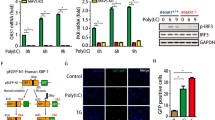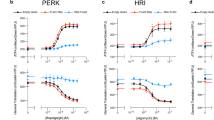Abstract
It has been shown previously that in mammalian cells, interferon-induced protein with tetratricopeptide repeats-1(IFIT1) is rapidly synthesized in response to viral infection, functions as an inhibitor of translation by binding to the eukaryotic initiation factor-3, and consequently assigns resistive activity against viral invasion to cells. It has also been reported that IFIT1 is rapidly produced in response to other cell stress agents with no direct relation to virus such as bacterial lipopolysaccharide and interleukin-1, but its function under these non-viral infection cell stress conditions has yet to be elucidated. Here, we demonstrate an interaction between IFIT1 and eukaryotic elongation factor-1A (eEF1A) both in vitro, using recombinant proteins as bait in pull-down assays, and in vivo, using laser confocal microscopy and immunoprecipitation. In addition, we report the initial determination of the domain of IFIT1 that mediates this interaction. We also display that both IFIT1 and eEF1A protein levels are rapidly elevated, prolonged in tumor necrosis factor alpha pre-treated Raw264.7 cells, and most of those cells are induced to death by the end of investigations. Our results imply that under some stressful stimulations IFIT1 may participate in cell death pathways by interaction with eEF1A.






Similar content being viewed by others
References
Wathelet M, Moutschen S, Defilippi P, Cravador A, Collet M, Huez G, Content J (1986) Molecular cloning, full-length sequence and preliminary characterization of a 56-kDa protein induced by human interferons. Eur J Biochem 155:11–17. doi:10.1111/j.1432-1033.1986.tb09452.x
Smith JB, Herschman HR (1996) The glucocorticoid attenuated response genes GARG-16, GARG-39, and GARG-49/IRG2 encode inducible proteins containing multiple tetratricopeptide repeat domains. Arch Biochem Biophys 330:290–300. doi:10.1006/abbi.1996.0256
Sikorski RS, Boguski MS, Goebl M, Hieter P (1990) A repeating amino acid motif in CDC23 defines a family of proteins and a new relationship among genes required for mitosis and RNA synthesis. Cell 60:307–317. doi:10.1016/0092-8674(90)90745-Z
Sen GC (2000) Novel functions of interferon-induced proteins. Semin Cancer Biol 10:93–101. doi:10.1006/scbi.2000.0312
Bluyssen HA, Vlietstra RJ, Faber PW, Smit EM, Hagemeijer A, Trapman J (1994) Structure, chromosome localization, and regulation of expression of the interferon-regulated mouse Ifi54/Ifi56 gene family. Genomics 24:137–148. doi:10.1006/geno.1994.1591
Ye S, Pang H, Gu YY, Hua J, Chen XG, Bao CD, Wang Y, Zhang W, Qian J, Tsao BP, Hahn BH, Chen SL, Rao ZH, Shen N (2003) Protein interaction for an interferon-inducible systemic lupus associated gene, IFIT1. Rheumatology 42:1155–1163. doi:10.1093/rheumatology/keg315
Guo J, Peters KL, Sen GC (2000) Induction of the human protein P56 by interferon, double-stranded RNA, or virus infection. Virology 267:209–219. doi:10.1006/viro.1999.0135
Guo J, Hui DJ, Merrick WC, Sen GC (2000) A new pathway of translational regulation mediated by eukaryotic initiation factor 3. EMBO J 19:6891–6899. doi:10.1093/emboj/19.24.6891
Guo J, Sen GC (2000) Characterization of the interaction between the interferon-induced protein P56 and the Int6 protein encoded by a locus of insertion of the mouse mammary tumor virus. J Virol 74:1892–1899. doi:10.1128/JVI.74.4.1892-1899.2000
Wathelet MG, Clauss IM, Nols CB, Content J, Huez GA (1987) New inducers revealed by the promoter sequence analysis of two interferon-activated human genes. Eur J Biochem 169:313–321. doi:10.1111/j.1432-1033.1987.tb13614.x
Smith JB, Herschman HR (1995) Glucocorticoid-attenuated response genes encode intercellular mediators, including a new C-X-C chemokine. J Biol Chem 270:16756–16765. doi:10.1074/jbc.270.28.16756
Browne GJ, Proud CG (2002) Regulation of peptide-chain elongation in mammalian cells. Eur J Biochem 269:5360–5368. doi:10.1046/j.1432-1033.2002.03290.x
Lamberti A, Caraglia M, Longo O, Marra M, Abbruzzese A, Arcari P (2004) The translation elongation factor 1A in tumorigenesis, signal transduction and apoptosis: review article. Amino Acids 26:443–448. doi:10.1007/s00726-004-0088-2
Chen E, Proestou G, Bourbeau D, Wang E (2000) Rapid up-regulation of peptide elongation factor ef-1a protein levels is an immediate early event during oxidative stress-induced apoptosis. Exp Cell Res 259:140–148. doi:10.1006/excr.2000.4952
Li L, Elledge SJ, Peterson CA, Bales ES, Legerski RJ (1994) Specific association between the human DNA repair proteins XPA and ERCC1. Proc Natl Acad Sci USA 91(11):5012–5016. doi:10.1073/pnas.91.11.5012
Donovan J, Brown P (1995) Current protocols in immunology. Wiley, New York
Shankar SL, O’Guin K, Kim M, Varnum B, Lemke G, Brosnan CF, Shafit-Zagardo B (2006) Gas6/Axl signaling activates the phosphatidylinositol 3-kinase/Akt1 survival pathway to protect oligodendrocytes from tumor necrosis factor alpha-induced apoptosis. J Neurosci 26:5638–5648. doi:10.1523/JNEUROSCI.5063-05.2006
Hui DJ, Bhasker CR, Merrick WC, Sen GC (2003) Viral stress-inducible protein p56 inhibits translation by blocking the interaction of eIF3 with the ternary complex eIF2.GTP.Met-tRNAi. J Biol Chem 278:39477–39482. doi:10.1074/jbc.M305038200
Hui DJ, Terenzi F, Merrick WC, Sen GC (2004) Mouse p56 blocks a distinct function of eukaryotic initiation factor 3 in translation initiation. J Biol Chem 280:3433–3440. doi:10.1074/jbc.M406700200
Sarkar SN, Sen GC (2004) Novel functions of proteins encoded by viral stress-inducible genes. Pharmacol Ther 103:245–259. doi:10.1016/j.pharmthera.2004.07.007
D’ Andrea LD, Regan L (2003) TPR protein: the versatile helixes. Trends Biochem Sci 28:655–662. doi:10.1016/j.tibs.2003.10.007
Das AK, Cohen PW, Barford D (1998) The structure of the tetratricopeptide repeats of protein phosphatase 5: implications for TPR-mediated protein-protein interactions. EMBO J 17:1192–1199. doi:10.1093/emboj/17.5.1192
Condeelis J (1995) Elongation factor 1 alpha, translation and the cytoskeleton. Trends Biochem Sci 20:169–170. doi:10.1016/S0968-0004(00)88998-7
Duttaroy A, Bourbeau D, Wang XL, Wang E (1998) Apoptosis rate can be accelerated or decelerated by overexpression or reduction of the level of elongation factor-1a. Exp Cell Res 238:168–176. doi:10.1006/excr.1997.3819
Lund A, Knudsen SM, Vissing H, Clark B, Tommerup N (1996) Assignment of human elongation factor 1alpha genes: EEF1A maps to chromosome 6q14 and EEF1A2 to 20q13.3. Genomics 36:359–361. doi:10.1006/geno.1996.0475
Kahns S, Lund A, Kristensen P, Knudsen CR, Clark BF, Cavallius J, Merrick WC (1998) The elongation factor1 A-2 isoform from rabbit cloning of the cDNA and characterization of the protein. Nucleic Acids Res 26:1884–1890. doi:10.1093/nar/26.8.1884
Ruest LB, Marcotte R, Wang E (2002) Peptide elongation factor eEF1A–2/S1 expression in cultured differentiated myotubes and its protective effect against caspase3 mediated apoptosis. J Biol Chem 277:5418–5425. doi:10.1074/jbc.M110685200
Borradaile NM, Buhman KK, Listenberger LL, Magee CJ, Morimoto ET, Ory DS, Schaffer JE (2005) A critical role for eukaryotic elongation factor 1A-1 in lipotoxic cell death. Mol Biol Cell 17:770–778. doi:10.1091/mbc.E05-08-0742
Acknowledgments
We are grateful to Ms. Liu Jin-Xiu for her help in mass spectrum analysis, to Ms. Shun Wei for her help in laser confocal microscopic observation, and to Dr. Yan Guo-He for her help in conducting cell transfections. This study was supported by grants from the National Key Basic Research and Development Plan of China (“973” projects. G1999054201 and 2005CB522605), and by grants from the Cooperative Research Foundation for Oversea Young Scholar of China (30328025).
Author information
Authors and Affiliations
Corresponding author
Rights and permissions
About this article
Cite this article
Li, HT., Su, YP., Cheng, TM. et al. The interaction between interferon-induced protein with tetratricopeptide repeats-1 and eukaryotic elongation factor-1A. Mol Cell Biochem 337, 101–110 (2010). https://doi.org/10.1007/s11010-009-0289-9
Received:
Accepted:
Published:
Issue Date:
DOI: https://doi.org/10.1007/s11010-009-0289-9




